Darwin's Radio Read online
Page 12
“Coffee doesn’t work, Saul,” Kaye said. “Tell me how you are. How you feel.”
“I feel fine,” he said defensively. “Success is the medication I need most right now.”
“This has nothing to do with business. It’s like the tides. You have your own tides to fight. You told me that yourself, Saul.”
Saul nodded but would not face her. “Going to the lab today?”
“Yes.”
“I’ll call from here after I make my inquiries. Let’s put together a bull session with the team leaders this evening, at the lab. Order in pizza. A keg of beer.” He made a valiant effort to smile. “We need a fallback position, and soon,” he said.
“I’ll see how the new work is going,” Kaye said. They both knew that any revenue from current projects, including the bacteriocin work, was at least a year down the road. “How soon will we—”
“Let me worry about that,” Saul said. He sidled over with a crablike motion, waggling his shoulders, self-mocking in that way only he could manage, and hugged her with one arm, dropping his face to her shoulder. She stroked his head.
“I hate this,” he said. “I really, really hate being like this.”
“You are very strong, Saul,” Kaye whispered into his ear.
“You’re my strength,” he said, and pushed away, rubbing his cheek like a little boy who has been kissed. “I love you more than life itself, Kaye. You know that. Don’t worry about me.”
For a moment, there was a lost, feral wildness in his eyes, cornered, nowhere left to hide. Then that passed, and his shoulders drooped and he shrugged.
“I’ll be fine. We’ll prevail, Kaye. I just have to make some calls.”
Debra Kim was a slender woman with a broad face and a smooth bowl of thick black hair. Eurasian, she tended to be quietly authoritarian. She and Kaye got along very well, though she was prickly with Saul and most men.
Kim ran the cholera isolation lab at EcoBacter with a glove of velvet-wrapped steel. The second largest lab in EcoBacter, the isolation lab functioned at level 3, more to protect Kim’s supersensitive mice than the workers, though cholera was no joke. She used severe combined immunodeficient, or SCID, mice, genetically shorn of an immune system, in her research.
Kim took Kaye through the outer office of the lab and offered her a cup of tea. They engaged in small talk for several minutes, watching through a pane of clear acrylic the special sterile plastic and steel containers stacked along one wall and the active mice within.
Kim was working to find an effective phage-based therapy against cholera. The SCID mice had been equipped with human intestinal tissues, which they could not reject; they thus became small human models of cholera infection. The project had cost hundreds of thousands of dollars and had produced slim results, but still, Saul kept it going.
“Nicki down in payroll says we may have three months left,” Kim said without warning, setting down her cup and smiling stiffly at Kaye. “Is that true?”
“Probably,” Kaye said. “Three or four. Unless we seal a partnership with Eliava. That would be sexy enough to bring in some more capital.”
“Shit,” Kim said. “I turned down an offer from Procter and Gamble last week.”
“I hope you didn’t burn any bridges,” Kaye said.
Kim shook her head. “I like it here, Kaye. I’d rather work with you and Saul then almost anyone else. But I’m not getting any younger, and I have some pretty ambitious work in mind.”
“So do we all,” Kaye said.
“I’m pretty close to developing a two-pronged treatment,” Kim said, walking to the acrylic panel. “I’ve got the gene connection between the endotoxins and adhesins. The cholerae attach to our little intestinal mucus cells and make them drunk. The body resists by shedding the mucus membranes. Rice-water stools. I can make a phage that carries a gene that shuts down pilin production in the cholera. If they can make toxin, they can’t make pili, and they can’t adhere to mucus cells in the intestine. We deliver capsules of phage to cholera-infected areas, voilà. We can even use them in water treatment programs. Six months, Kaye. Just six more months and we could hand this over to the World Health Organization for seventy-five cents a dose. Just four hundred dollars to treat an entire water purification plant. Make a very tidy profit and save several thousand lives every month.”
“I hear you,” Kaye said.
“Why is timing everything?” Kim asked softly, and poured herself another cup of tea.
“Your work won’t stop here. If we go under, you can take it with you. Go to another company. And take the mice. Please.”
Kim laughed, then frowned. “That’s insanely generous of you. What about you? Are you just going to bite the bullet and sink under the debts, or declare bankruptcy and go to work for the Squibb? You could get work easily enough, Kaye, especially if you strike before the publicity dies down. But what about Saul? This company is his life.”
“We have options,” Kaye said.
Kim drew the ends of her lips down in concern. She put her hand on Kaye’s arm. “We all know about his cycles,” she said. “Is this getting to him?”
Kaye half shuddered, half shivered at this, as if to throw off any unpleasantness. “I can’t talk about Saul, Kim. You know that.”
Kim threw her hands up in the air. “Christ, Kaye, maybe you could use all the publicity to take the company public, get some funding. Tide us over for another year . . .”
Kim had very little sense of how business worked. She was atypical this way; most biotech researchers in private companies were very savvy about business. No francs, no Frankenstein’s monster, she had heard one of her colleagues say. “We couldn’t convince anybody to back us for a public offering,” Kaye said. “SHEVA has nothing to do with EcoBacter, not now at any rate. And cholera is Third World stuff. It isn’t sexy, Kim.”
“It isn’t?” Kim said, and fluttered her hands in disgust. “Well, what in hell is sexy in the big old bidness world today?”
“Alliances and high profits and stock value,” Kaye said. She stood and tapped the plastic panel near one of the mouse cages. The mice inside reared up and wriggled their noses.
Kaye walked into Lab 6, where she did most of her research. She had handed off her bacteriocin studies a month ago to some postdocs in Lab 5. This lab was being used by Kim’s assistants for the time being, but they were at a conference in Houston, and the lab had been closed, the lights turned off.
When she wasn’t working on antibiotics, her favorite subjects had been Henle 407 cultures, derived from intestinal cells; she had used them to meticulously study aspects of mammalian genomes, and to locate potentially active HERV. Saul had encouraged her, perhaps foolishly; she could have focused completely on the bacteriocin research, but Saul had assured her she was a golden girl. Anything she touched would advance the company.
Now, lots of glory, but no money.
The biotech industry was unforgiving at best. Maybe she and Saul simply did not have what it took.
Kaye sat in the middle of the lab on a rolling chair that had somehow lost a wheel, leaned to one side, hands on her knees and tears slicking her cheeks. A small and persistent voice in the back of her head told her that this could not go on. The same voice continued to warn her that she had made bad choices in her personal life, but she could not imagine how she could have done otherwise. Despite everything, Saul was not her enemy; far from being a brutal or abusive man, he was simply a victim of tragic biological imbalances. His love for her was pure enough.
What had started her tears was this treasonous inner voice that insisted that she should get out of this situation, abandon Saul, start over again; no better time. She could get work in a university lab, apply for funding for a pure research project that suited her, escape this damned and very literal rat race.
Yet Saul had been so loving, so right when she had returned from Georgia. The paper on evolution had seemed to rekindle his interest in science over profit. Then . . . the setbacks, t
he discouragement, the downward spiral. Bad Saul.
She did not want to face again what had happened eight months ago. Saul’s worst breakdown had tested her own limits. His attempted suicides—two of them—had left her exhausted, and, more than she cared to admit, embittered. She had fantasized about living with other men, calm and normal men, men closer to her own age.
Kaye had never told Saul about these wishes, these dreams; she wondered if perhaps she needed to see her own psychiatrist, but she had decided against it. Saul had spent tens of thousands of dollars on psychiatrists, had gone through five regimens of drug therapy, had once suffered complete loss of sexual function and weeks of being unable to think clearly. For him, the miracle drugs did not work.
What did they have left, what did she have left in the way of reserves, if the tide turned again and she lost Good Saul? Being around Saul in the bad times had eaten at some other reserve—a spiritual reserve, generated during her childhood, when her parents had told her, You are responsible for your life, your behavior. God has given you certain gifts, beautiful tools . . .
She knew she was good; once, she had been autonomous, strong, inner-directed, and she wanted to feel that way again.
Saul had an outwardly healthy body, and intellectually a fine mind, yet there were times when, through no fault of his own, he could not control his existence. What then did this say about God and the ineffable soul, the self? That so much could be skewed by mere chemicals . . .
Kaye had never been too strong on the God thing, on faith; the crime scenes in Brooklyn had stretched her belief in any sort of fairy-tale religion; stretched it, then broke it.
But the last of her spiritual conceits, the last tie she had to a world of ideals, was that you controlled your own behavior.
She heard someone come into the lab. The light was switched on. The broken chair squeaked and scraped as she turned. It was Kim.
“Here you are!” Kim said, her face pale. “We’ve been looking all over for you.”
“Where else would I be?” Kaye asked.
Kim held out a portable lab phone. “It’s from your house.”
18
The Centers for Disease Control and Prevention, Atlanta
Mr. Dicken, this isn’t a baby. It wasn’t ever going to be a baby.”
Dicken looked over the photos and analysis of the Crown City miscarriage. Tom Scarry’s battered old steel desk sat at the end of a small room with pale blue walls, filled with computer terminals, adjacent to Scarry’s viral pathology lab in Building 15. The top of the desk was littered with computer disks, photos, and folios filled with papers. Somehow, Scarry managed to keep his projects sorted; he was one of the best tissue analysts in the CDC.
“What is it, then?” Dicken asked.
“It may have started out as a fetus, but nearly all the internal organs are severely underdeveloped. The spine hasn’t closed—spina bifida would be one interpretation, but in this case, there’s a whole series of nerves branching to a follicular mass in what would otherwise be the abdominal cavity.”
“Follicular?”
“Like an ovary. But containing only about a dozen eggs.”
Dicken drew his brows together. Scarry’s pleasant drawl matched a friendly face, but his smile was sad.
“So—it would have been a female?” Dicken asked.
“Christopher, this fetus miscarried because it is the most screwed up arrangement of cellular material I’ve ever seen. Abortion was a major act of mercy. It might have been female—but something went very wrong in the first week of the pregnancy.”
“I don’t understand—”
“The head is severely malformed. The brain is just a nubbin of tissue at the end of a shortened spinal cord. There is no jaw. The eye sockets are open at the side, like a kitten’s. The skull looks more like a lemur’s, what there is of it. No brain function would have been possible after the first three weeks. No metabolism could have been established after the first month. This thing functions as an organ drawing sustenance, but it has no kidneys, a very small liver, no stomach or intestines to speak of . . . A kind of heart, but again, very small. The limbs are just little fleshy buttons. It’s not much more than an ovary with a blood supply. Where in hell did this come from?”
“Crown City Hospital,” Dicken said. “But don’t spread that around.”
“My lips are sealed. How many of these have they had?”
“A few,” Dicken said.
“I’d start looking for a major source of teratogens. Forget thalidomide. Whatever caused this is pure nightmare.”
“Yeah,” Dicken said, and pressed the bridge of his nose with his fingers. “One last question.”
“Fine. Then get it out of here and let me get back to a normal existence.”
“You say it has an ovary. Would the ovary function?”
“The eggs were mature, if that’s what you’re asking. And one follicle appears to have ruptured. I said that in my analysis . . .” He flipped back sheets from the paper and pointed, impatient and a little cross, more with Nature than him, Dicken thought. “Right here.”
“So we have a fetus that ovulated before it was miscarried?” Dicken asked, incredulous.
“I doubt it got that far.”
“We don’t have the placenta,” Dicken said.
“If you get one, don’t bring it to me,” Scarry said. “I’m spooked enough. Oh—one more thing. Dr. Branch dropped off her tissue assay this morning.” Scarry pushed a single paper across the desk, lifting it delicately to clear the other material.
Dicken picked it up. “Christ.”
“You think SHEVA could have done this?” Scarry asked, tapping the analysis.
Branch had found high levels of SHEVA particles in the fetal tissue—well over a million particles per gram. The particles had suffused the fetus, or whatever they might call the bizarre growth; only in the follicular mass, the ovary, were they virtually absent. She had posted a small note at the end of the page.
These particles contain less than 80,000 nucleotides of single-stranded RNA. They all are associated with an unidentified 12,000+ kilodalton protein complex in the host cell nucleus. The viral genome demonstrates substantial homology with SHEVA. Talk to my office. I’d like to obtain fresher samples for accurate PCR and sequencing.
“Well?” Scarry persisted. “Is this caused by SHEVA or not?”
“Maybe,” Dicken said.
“Does Augustine have what he needs now?”
Word spread fast at 1600 Clifton Road.
“Not a peep to anyone, Tom,” Dicken said. “I mean it.”
“No suh, massa.” Scarry zipped his lips with a finger.
Dicken shuffled the report and the analysis into a folder and glanced at his watch. It was six o’clock. There was a possibility Augustine was still in his office.
Six more hospitals in the Atlanta area, part of Dicken’s network, were reporting high rates of miscarriage, with similar fetal remnants. More and more were testing for, and finding, SHEVA in the mothers.
That was something the surgeon general would definitely want to know.
19
Long Island, New York
A bright yellow fire truck and a red Emergency Response vehicle had parked in the gravel driveway. Their rotating red and blue lights flashed and brightened the afternoon shadows on the old house. Kaye drove past the fire truck and parked behind the ambulance, eyes wide and palms damp, her heart in her throat. She kept whispering, “God, Saul. Not now.”
Clouds blew in from the east, breaking up the afternoon sun, raising a gray wall behind the brilliant emergency lights. She opened the car door, stepped out, and stared at two firemen, who blandly returned her look. A slow and warmer breeze gently combed her hair. The air smelled damp, close; there might be thunder this evening.
A young paramedic approached. He looked professionally concerned and held a clipboard. “Mrs. Madsen?”
“Lang,” she said. “Kaye Lang. Saul’s wife.” Kaye t
urned to gather her wits and saw for the first time the police car parked on the other side of the fire truck.
“Mrs. Lang, we received a call from a Miss Caddy Wilson—”
Caddy pushed open the front screen door and stood on the porch, followed by a police officer. The door slammed woodenly behind them, a familiar, friendly sound suddenly made ominous.
“Caddy!” Kaye waved. Caddy made a little run down the steps, clutching her light cotton skirt in front of her, wisps of pale blond hair flying. She was in her late forties, thin, with strong wiry forearms and manly hands, a handsome stalwart face, large brown eyes that now looked both concerned for Kaye and a little panicked, like a horse about to bolt.
“Kaye! I came to the house this afternoon, like always—”
The paramedic interrupted her. “Mrs. Lang, your husband is not in the house. We haven’t found him.”
Caddy stared at the medic resentfully, as if, of all people, this was without a doubt her story to tell. “The house is an incredible sight, Kaye. There’s blood—”
“Mrs. Lang, perhaps you should talk to the police first—”
“Please!” Caddy shrieked at the paramedic. “Can’t you see she’s scared?”
Kaye took Caddy’s hand and made a small shushing noise. Caddy wiped her eyes with her wrist and nodded, swallowing twice. The police officer joined them, tall and bull-bellied, skin deep black, hair swept neatly back above a high forehead and a patrician face; wise, tired eyes with golden sclera. She thought he was really quite striking, much more prepossessing than the others in the yard.
“Missus . . .” The officer began.
“Lang,” the paramedic offered.
“Missus Lang, your house is in something of a state—”
Kaye started up the porch steps. Let them work out the jurisdiction and procedure. She had to see what Saul had done before she could have any idea as to where Saul might be, what he might have done since . . . Might be doing even now.

 Foundation and Chaos
Foundation and Chaos Halo: Silentium
Halo: Silentium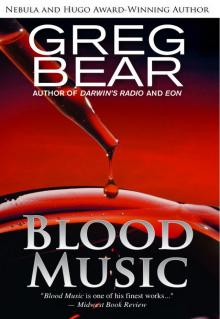 Blood Music
Blood Music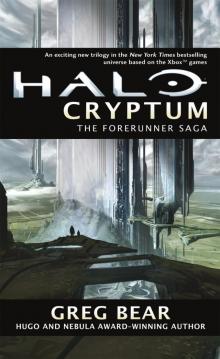 Halo: Cryptum
Halo: Cryptum Halo: Primordium
Halo: Primordium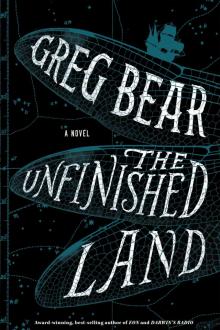 The Unfinished Land
The Unfinished Land Hardfought
Hardfought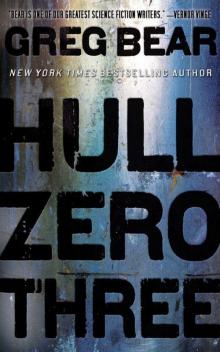 Hull Zero Three
Hull Zero Three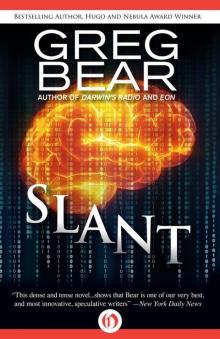 Slant
Slant Multiverse: Exploring the Worlds of Poul Anderson
Multiverse: Exploring the Worlds of Poul Anderson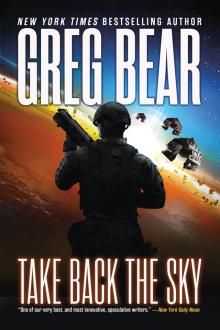 Take Back the Sky
Take Back the Sky Nebula Awards Showcase 2015
Nebula Awards Showcase 2015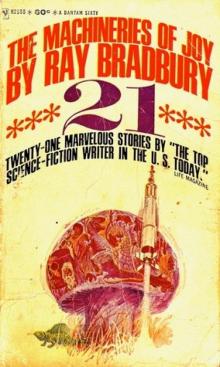 Machineries Of Joy
Machineries Of Joy A Martian Ricorso
A Martian Ricorso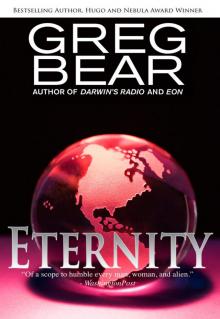 Eternity
Eternity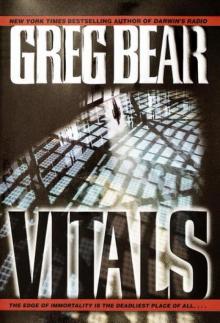 Vitals
Vitals The Infinity Concerto
The Infinity Concerto Beyond the Farthest Suns
Beyond the Farthest Suns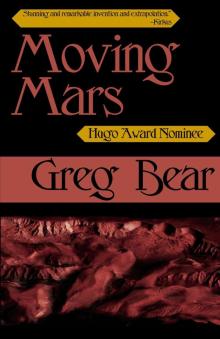 Moving Mars
Moving Mars Quantico
Quantico Darwin's Radio
Darwin's Radio Beyond Heaven's River
Beyond Heaven's River Star Wars - Rogue Planet
Star Wars - Rogue Planet Legacy (Eon, 1)
Legacy (Eon, 1) War Dogs: Ares Rising
War Dogs: Ares Rising Sisters
Sisters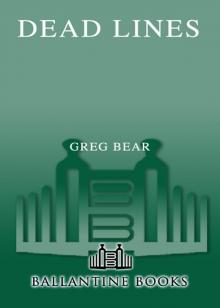 Dead Lines
Dead Lines Just Over the Horizon (The Complete Short Fiction of Greg Bear Book 1)
Just Over the Horizon (The Complete Short Fiction of Greg Bear Book 1) Eon (Eon, 2)
Eon (Eon, 2) Venging
Venging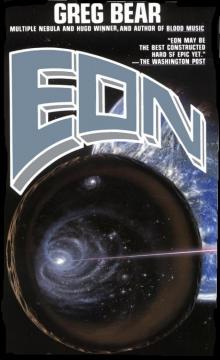 Eon
Eon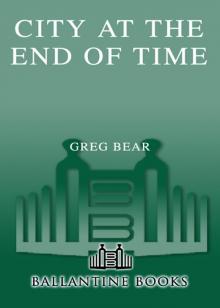 City at the End of Time
City at the End of Time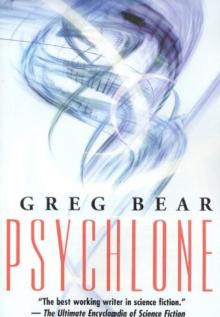 Psychlone
Psychlone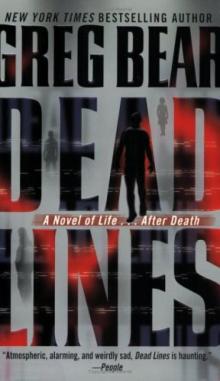 Dead Lines, A Novel of Life... After Death
Dead Lines, A Novel of Life... After Death Eternity (Eon, 3)
Eternity (Eon, 3) Cryptum
Cryptum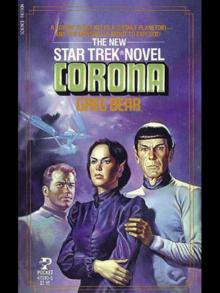 Corona
Corona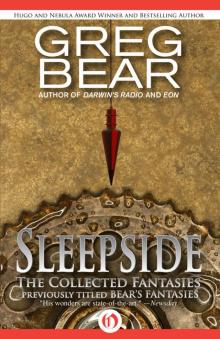 Sleepside: The Collected Fantasies
Sleepside: The Collected Fantasies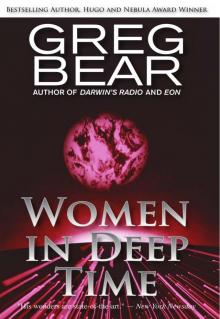 Women in Deep Time
Women in Deep Time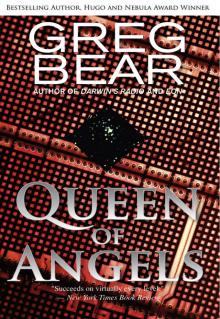 Queen of Angels
Queen of Angels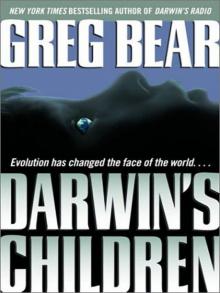 Darwin's Children
Darwin's Children Dinosaur Summer
Dinosaur Summer The Forge of God tfog-1
The Forge of God tfog-1 Foundation and Chaos f-9
Foundation and Chaos f-9 Star Wars: Rogue Planet
Star Wars: Rogue Planet The Forge of God
The Forge of God Mariposa
Mariposa Halo: Cryptum: Book One of the Forerunner Saga
Halo: Cryptum: Book One of the Forerunner Saga Strength of Stones
Strength of Stones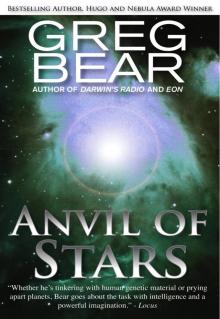 Anvil of Stars
Anvil of Stars B00AQUQDQO EBOK
B00AQUQDQO EBOK Anvil of Stars tfog-2
Anvil of Stars tfog-2 Ares Rising 1: War Dogs
Ares Rising 1: War Dogs Rogue Planet (star wars)
Rogue Planet (star wars) The Machineries of Joy
The Machineries of Joy Far Thoughts and Pale Gods
Far Thoughts and Pale Gods Songs of Earth and Power Omnibus
Songs of Earth and Power Omnibus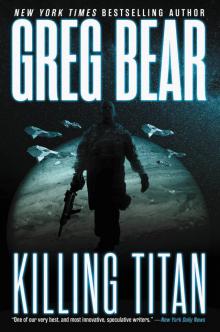 Killing Titan
Killing Titan Darwin's Radio d-1
Darwin's Radio d-1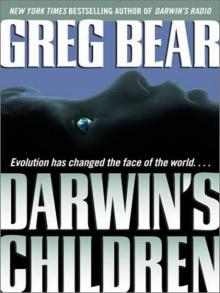 Darwin's Children d-2
Darwin's Children d-2